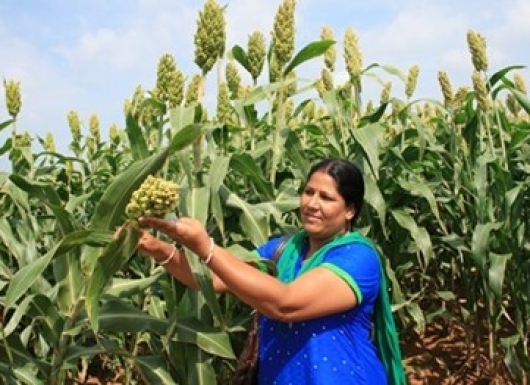Submitter: (ICRISAT)
Livestock contributes significantly to the income of farmers, particularly smallholder households. Globally, in low and middle-income countries (LMICs), livestock contributes to about 25% of agricultural GDP. In India, livestock contribute 14-16 % to the total income. Livestock production, including milk, meat, and eggs, is a major source of income for farmers, with milk production leading the way. The sector also provides nutrition and employment to a large portion of the rural population. The availability of quality fodder round the year is immensely important for farmers across the world. In case of India, the ICAR-Indian Grassland and Fodder Research Institute (IGFRI) has estimated a deficit of 11.24% for green fodder and 23% for dry fodder. This shortage is impacting animal productivity and contributing to rising milk production costs. In India, quality fodder production is a subject of research in almost all State Agricultural Universities as well as selected institutes of Indian Council of Agricultural Research (ICAR). ICRISAT also focuses on development of quality and multi-cut fodder in sorghum and pearl millet. Several high yielding hybrids and OPVs have been released by the national system in India and abroad, using ICRISAT Breeding material. Small millets, that adapted to varying environmental condition, also produce good quality stover in addition to the grains.

Despite the opportunities that livestock markets offer, there remain significant challenges to small livestock producers. The levels of basic animal productivity on most farms are typically well below those on commercial farms. In some cases, for example, gaps in beef productivity between small-scale and commercial farms are 130 per cent and as high as 430 per cent in the case of milk production. Many factors, including inadequate or low-quality fodder and feed cause these gaps. Availability of high yielding fodder crops, especially in the drylands, where soils are severely degraded, can improve the farmers livelihoods.
Green/dry forage with high protein and digestibility are needed to enhance the crop-livestock efficiency of farms. New brown midrib (bmr) sorghum and pearl millet varieties and hybrids offer a considerable improvement in fodder quality. Brown midrib sorghum varieties improve fodder quality by reducing lignin content, particularly in the stems and leaves. This reduction in lignin leads to higher digestibility of the cell walls, making the fiber easier for livestock to digest and utilize, ultimately improving the energy or total digestible nutrient (TDN) value of the forage.
Sorghum hybrids and OPV, specially bred for fodder purpose, offer the advantage of silage making, at water use efficiency much higher than maize. Silage offers the possibility of making fodder available to livestock (especially cattle) during the lean season and ensuring higher productivity (milk and meat) throughout. Jaicar Chari (CSV 47 F), a single cut forage sorghum variety with 430-450 q ha-1 green fodder yield, 120-130 q ha-1 dry fodder yield; CSH 24 MF, a multi-cut fodder sorghum hybrid with 914 q ha-1 green fodder yield and 232 q ha-1 dry fodder yield; Jaicar Nutrigaze (CSV 43 BMR), a brown midrib dual-purpose variety with low lignin content and high digestibility that are released for cultivation in India, and others developed using ICRISAT-bred material are suitable for scaling.
ILRI (International Livestock Research Institute) research results have indicated that a 1% increase in stover digestibility in crops can result into increases in milk, meat and draught power outputs ranging from 6-8%. Many studies revealed that dry matter intake and body condition score were not significantly different between cows fed bmr and standard sorghum, but cows fed bmr sorghum resulted in long-term milk production greater than cows fed standard sorghum and similar to cows fed corn silage. The newly developed climate resilient dual-purpose barley using ICARDA’s germplasm showed a notable 44% increase in income per hectare, derived mainly from grain (29%) and straw (15%). These versatile barley varieties offer promising economic prospects for farmers.
Jaicar Nutrigaze (CSV 43 BMR) developed using ICRISAT-bred material is a brown midrib variety released in India characterized with low lignin content, high digestibility, dual purpose variety with yield potential of 21-23 q ha-1 for grain yield, 155-160 q ha-1 for fodder yield.
CSH 24 MF is a sorghum multi-cut fodder hybrid developed using ICRISAT-bred ICSA 467 as the female parent. It was released in India for cultivation with yield potential of 914 q ha-1 for green fodder yield, and 232 q ha-1 for dry fodder yield. This hybrid was hailed as a “Landmark cultivar in India” for revolutionizing forage sorghum production in India.
https://www.smartfood.org/project/sorghum-hybrid-recognized-as-outstanding-forage-hybrid-2019/
https://www.cgiar.org/news-events/news/forage-sorghum-hybrid-hailed-as-a-landmark-cultivar-in-india-2/
ICRISAT offer seed and planting material of high yielding and high-quality fodder varieties to smallholder farmers in partner countries. Forage cultivars of sorghum and pearl millet having high protein and digestibility can improve livestock feed efficiency. New brown mid-rib (bmr) sorghum and pearl millet varieties offer added quality advantage over the ordinary varieties. There are many bmr based commercial hybrids and OPVs available in sorghum, but for pearl millet the trait has been introgressed into many inbred lines, suitable as parents for hybrids. ICRISAT can make these germplasms available early to partner countries.
Ephrem Habyarimana, Email : Ephrem.Habyarimana@icrisat.org